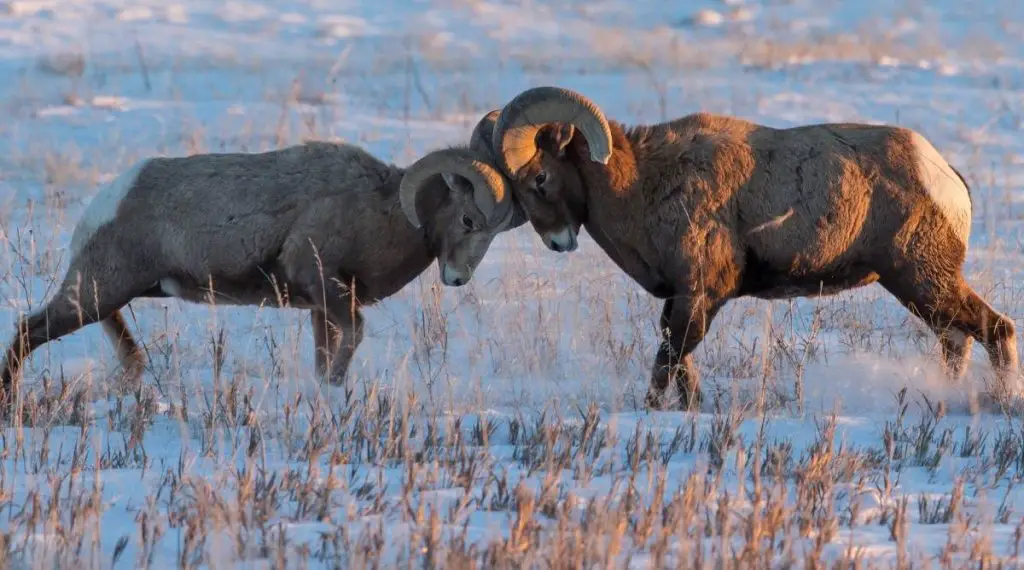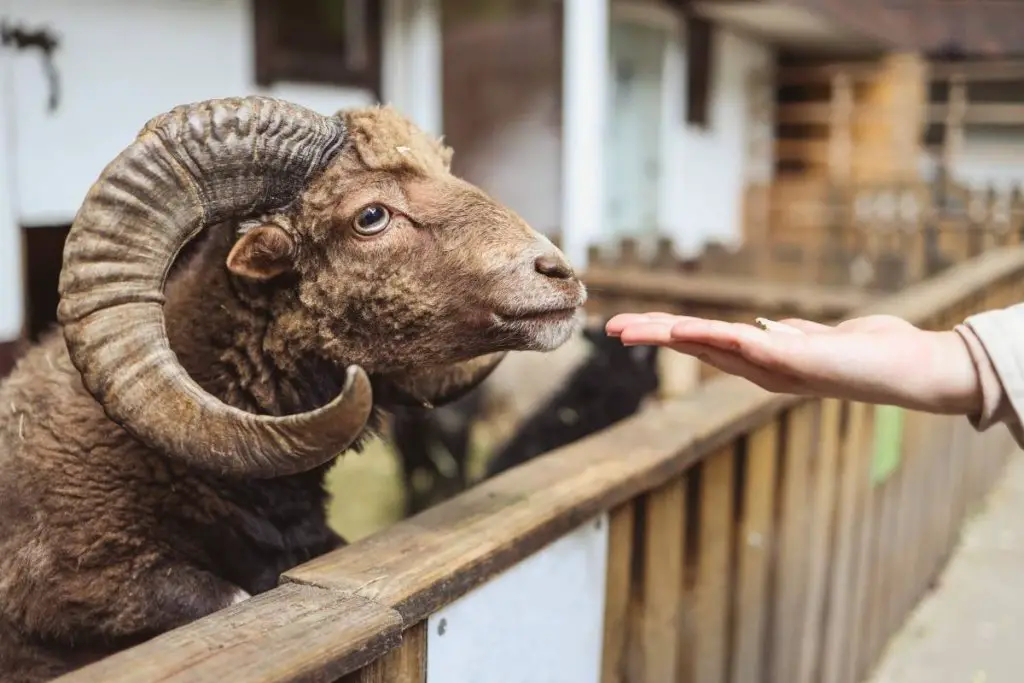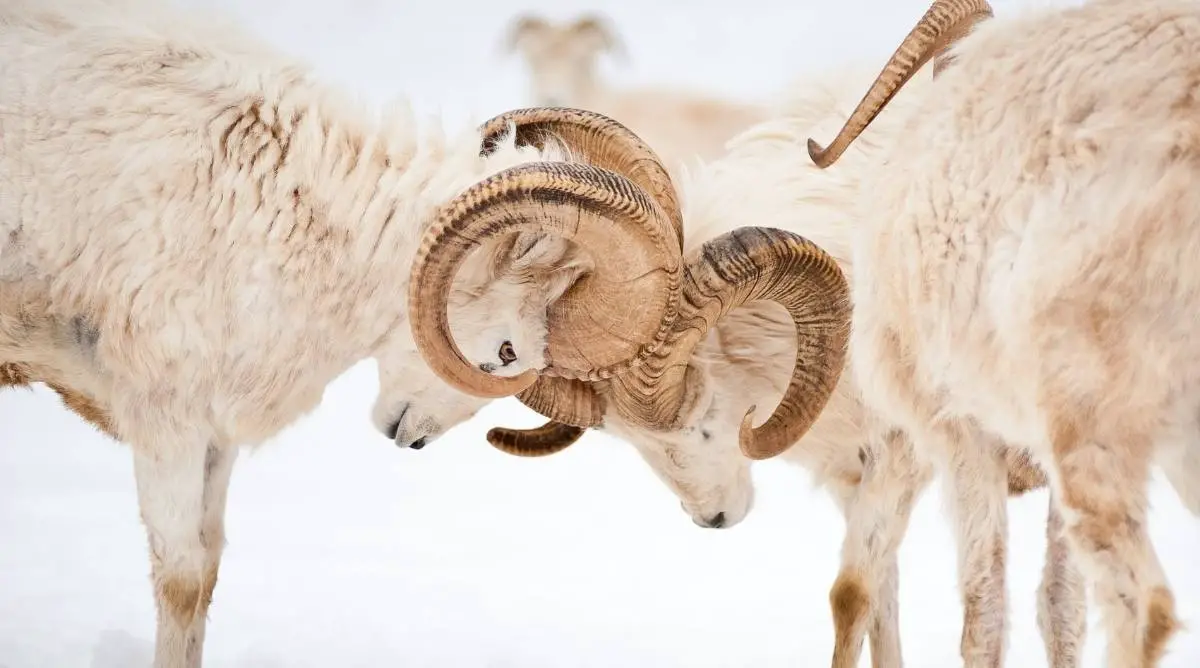Rams headbutt to assert dominance over other rams, to assert their rights over a territory, and to fight over ewes during mating season. The ram that wins a headbutting contest wins the right to mate with the ewes.
Table of Contents
Ram headbutting behavior
Headbutting is both a natural and learned behavior among sheep. Rams in the wild headbutt as a contest for dominance and to mate with ewes, and this trait persists in domesticated sheep.
Only dominant rams get to mate with the ewes, which is why headbutting takes on such importance. Even in captivity, rams headbutt for dominance. This is especially true during rutting season, which signals that the ewes of the flock are starting their estrus activity.
Rams headbutt as a way to be physically prepared for the breeding season, as well as to establish the hierarchy related to their dominance.
When do rams headbutt?
Headbutting starts when rams are young, especially during times when their testosterone levels are high. Ram lambs headbutt, but they may just be playing or emulating adult rams.
In adult rams, headbutting is common when they encounter unfamiliar individuals. Once a hierarchy is established, headbutting can be reduced.
Because of their instinct to headbutt, rams can be dangerous and must be treated with caution.
Even though rams typically headbutt each other, ewes sometimes headbutt other ewes or rams when they think it is needed. Ewes may also headbutt lambs, especially when they want to push lambs away when the lambs want to nurse but the ewes do not want to. Ewes may also headbutt lambs that are not their own.
Mechanics of a ram headbutt

A bighorn sheep can produce about 764 pounds of force (3400 newtons) from a headbutt. How powerful is this? It’s enough force to crack a human skull.
The closest human parallel may be American football. When linebackers tackle, they can create forces of 970 pounds (or more). However, the force of a ram’s charge is entirely in their horns, making their charges more potentially lethal.
When rams are planning to charge another ram or a human, they start backing away. When the other ram accepts the challenge, that ram also backs away. This is why it’s important not to back away. A ram may interpret your behavior as a sign that you’ve accepted its challenge.
Before a ram charges, it will lower its head. Once rams begin to charge, they run at up to 40 miles an hour. This makes them difficult to outrun them once they get going.
Consequences of ram headbutting
For rams, there usually aren’t major consequences to headbutting. Their horns are made out of multiple layers of keratin, which help to absorb the impact and shocks from headbutting.
Scientists have a hypothesis to explain why rams aren’t injured even with repeated headbutting: the Bubble Wrap Effect.
The Bubble Wrap Effect refers to the phenomenon of the brain having a higher concentration of blood during a headbutting collision. This higher concentration of blood prevents the brain from getting a concussion, bruises, or other brain damage.
Although headbutting isn’t necessarily dangerous for rams themselves, it can be dangerous for farmers. It’s necessary to approach rams with caution, and to train them from an early age to avoid headbutting behavior as much as possible.
Reducing ram headbutts

There are a few ways to reduce ram headbutts:
- Don’t touch a ram’s head: Never touch the head of the ram. This is interpreted as a sign of aggression and may be met with headbutting behavior. Avoid lowering your head near a ram, as this may also be interpreted as aggression.
- Use a ram shield: Interact with rams using a ram shield. A ram shield is a device that blocks the ram’s forward vision. Note that rams can still see at the sides (so it will see a person standing next to it). Before putting a ram shield on the ram, ensure that it does not get entangled in fences or gates.
- House rams separately: When housing two rams that headbutt frequently, consider introducing them at a slower pace. This may mean separating them first and introducing them with a barrier between both rams. Once they are more comfortable, they can be put together in the same coral for a short time, gradually increasing until they can live together.
- Avoid hand-rearing rams: Rams that grow up with close human contact seem docile at the start, but they are the most dangerous because they have no fear of humans.
- Always keep your eyes on a ram: Never turn your back on a ram. Keep your eyes on them at all times. They can charge quickly.
Signs a ram may be getting aggressive
Look out for these signs of aggressive ram behavior:
- Backing away from you
- Lowering its head after backing away
Rams mostly headbutt to assert dominance, but this natural behavior can easily spill over to human caretakers.
What to do if a ram charges you
If a ram looks like it’s going to charge you, follow these steps:
- Walk slowly toward a ram as it backs away. Backing away from rams is a sign you’ve accepted their headbutting challenge, and running away is difficult since rams can charge at up to 40 mph. Walking toward them as they back away may disorient them. Only do this if by walking toward them, you can more safely get close to an exit, a tree, or another way to protect yourself.
- Wave a large stick. Waving a large stick makes you appear bigger and more threatening than you are and can stop a ram’s charge. Swing it directly in front of you, creating space between you and the ram.
- Dodge. If a ram charges you, your best option is to dodge to the side as it gets close. Its momentum will carry it away and disorient it, giving you time to get to safety.

